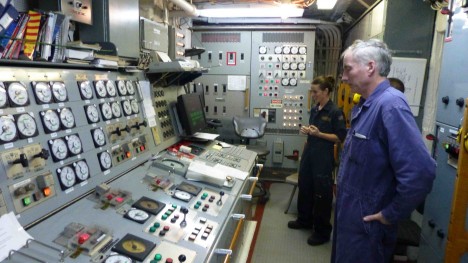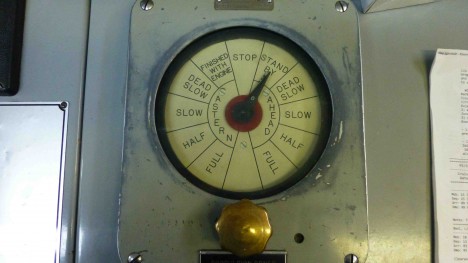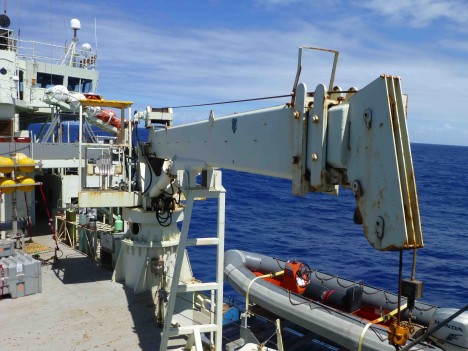By Eric Lindstrom
The Research Vessel Knorr is a fantastically capable oceanographic research vessel. She has traveled over 2 million miles and explored all the major oceans in her around 40 years of service.
As a visiting oceanography research crew, we have our space on the ship, for which we have free run. We are mostly in the main labs, on deck, or in the mess (getting fed very well indeed!) Much of the ship is off-limits to personnel other than the crew. I asked for a tour so I could give you a quick view of some “hidden” portions of the ship that make everything work. The daily routine is for the scientists to request that the ship, with her propulsion, station-keeping, cranes, winches, and capstans, to go here, stop there, stay still, lift this, pick up that… and so on, with only vague appreciation of the engineering feats behind these daily miracles.
I was privileged to get a tour of Knorr’s engineering space from the Chief Engineer Steve Walsh. He has been with Woods Hole Oceanographic Institution and aboard the Knorr for many years and participated in the vessel’s complete refit in 1991.
In 1991, the ship was basically cut in two pieces and 34 feet were added to her mid-section. The new engine room was placed in the new section and the space freed up in the after section (the old engine room) is now used as a workshop, welding room, and scientific cargo space.
At the noisy heart of the ship are the engines (3500 Series Caterpillar). These run the four generators that supply 600V energy for all the ship’s electrical needs (which are many). The voltage is stepped down for various different purposes to 480V, 220V, and 120V (like in your house). The generators drive electric motors for primary propulsion, thrusters, and supply power for air conditioning, refrigeration, cranes, winches, lighting, computing, navigation and the coffee machine. According to Steve the most critical elements by far are the air conditioning and the coffee machine. OK, he’s half-joking…but I know he is serious about the coffee machine!
It seems to me like the Knorr is, in some ways, like my all-electric home back in Maryland. When the power goes out, it’s a hollow, dark, cold shell of a place. Except on Knorr, we have the power company living in the basement using diesel engines to run the generators to keep our lights on. And unlike my house, the Knorr can also get up and go wherever oceanography takes her and use a crane to pick up the garage and car (or 10,000-lb mooring anchors) to go along for the trip. Knorr has all the comforts of home, work, and play for our 33 days at sea. They are all in one awesome package. All powered by home-grown, engineer-maintained, electricity.
Coffee anyone?
Tags: engineering, Knorr, NASA, oceanography, SPURS, SPURS1, vessel










Eric – I am loving this blog series. It brings back many fond memories of my only oceanographic expedition, on the R/V Maurice Ewing in August of 1990. Your logs hit the mark in their descriptions of shipboard life, both the exciting parts and the less-so. I envy you and your shipmates more than I can possible describe. Keep up the great posts!
Eric,
Glad you are enjoying the blog. Its been a great experience (both the expedition and the blogging). I really missed the sea (about 15 years since I left my career as a seagoing oceanographer), so perhaps some of that is leaking into my blogging. I cannot stop leaking enthusiasm!